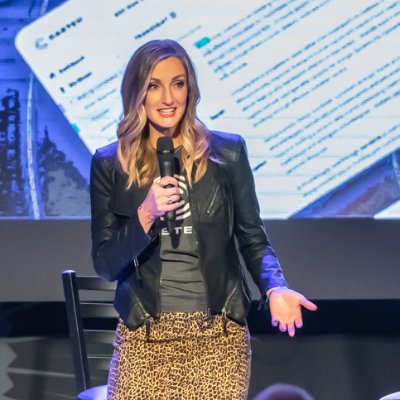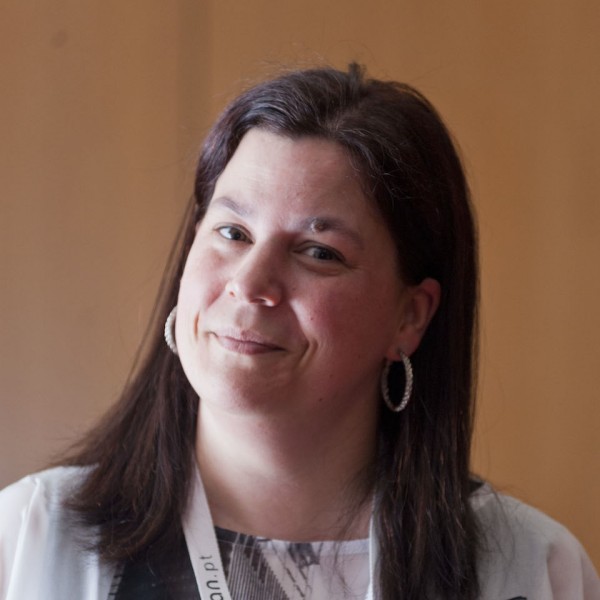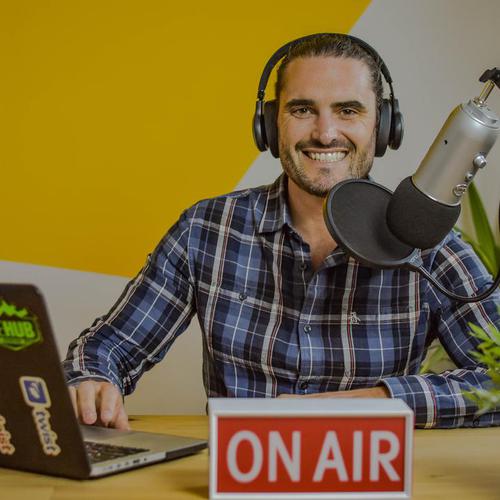Lindsay Tjepkema knows marketing. So when she started her own company, she knew the importance of understanding her audience and delivering her message in a way that resonated.
But what happens when the audience is your internal team?
Getting the message across
Lindsay says anytime you need to communicate internally, whether it’s your board, team, or anyone else, you need to know your audience and why you are communicating.
Digital leaders can’t get by just with Word documents, slides, and emails anymore. There are so many options available: instant messages, podcasts, streaming video, recorded webinars, and much more.
Leaders need to be able to understand the advantages of multiple kinds of communication and pick the one that best fits their needs.
Much like marketers, leaders also need to repeat themselves often to make sure the point gets across.
Making better use of audio
Each media has its advantages and disadvantages. For example, podcasts are great at getting raw thought processes out there, and they also add some signals like speed, tone of voice, and intonation. However, a podcast may not be the right idea when you need to deliver a message perfectly and want to be able to edit what you say.
Audio as a medium is also unique in that you can multitask while consuming it. Whereas someone needs to sit down and read an email or watch a video without distractions, they are able to take a walk or a drive while consuming audio.
Links
Welcome back to The Digital Workplace podcast. Today our guest is Lindsay Tjepkema. She is the CEO of Casted. Hey Lindsay, how are you doing today?
I am fantastic. Thanks for having me here.
I’m excited just to get to talk with you. I’ve seen you from afar for a while. Your products are all about podcasting. So, I’m very interested in talking about this topic and how we can use it internally. But first, I need to make sure you are a real live human and not a robot talking to us. So, your capture question is, what is your favorite condiment or spice?
Frank’s RedHot Buffalo sauce.
Hmm alright.
Yes, yes.
So, you put it on everything or anything particular?
It’s funny because I think the tagline is ‘Put that on everything. You put that ish on everything.’ And I think that’s me. So, I can’t have dairy. I have a dairy allergy, but I love dairy, so I miss it. And so, I think that helps make up for it. I love ranch dressing and I love sour cream and stuff. But I’m like, okay. If I can at least have some spice, so yeah. I put it on burgers and turkey burgers and chicken nuggets. Yeah, it’s surprisingly versatile.
There’s something about buffalo sauce that almost seems like it should be dairy. I don’t know if it’s just that association with blue cheese and stuff.
See, that’s kind of why I brought up the dairy thing is because I feel like it’s somehow in a way that makes zero sense. It feels like a good replacement. It’s like, well, I can’t have the blue cheese, but I can have the buffalo sauce.
Yes. And I do not think there’s a more human answer that you could have given to that question. So, you are completely certified. Especially with dairy allergies, like what more could you want?
Sure okay. Yeah, it’s very lame.
Let’s jump into this. First, tell us a little bit about Casted, a little bit of the story behind that.
Yeah, so my background in my career is marketing. So, I spent 15 years as a marketer, progressively from marketing manager and generalist all the way and up to. Right before starting Casted, I was VP of Marketing for a global enterprise SaaS company where I was brought in specifically to build up and lead a content marketing team strategy function and really build up the brand. And so, in doing that, long story short, part of the strategy and effort to build connections with our audience, both internally and externally, which I think we’re going to talk about today, I moved to podcasts and a video series. So, its audio and video content.
So, hey, this is the best way to reach our audience. This is what’s going to be most engaging and also gives us a way to tap into the expertise of others, not just for the show, but really to fuel other content too. And it will make writing blog posts easier and articles easier and getting in the hands of our sales team easier. We were right. It was effective. That was the upside. The downside was that there was no software to do what I needed to do. As this marketing leader, I couldn’t get something in the hands of my marketing team to be able to do what I was asking them to do. We had to piecemeal together solutions and tools and that made it really hard for them. Impossible to measure what we were doing in a way that was relevant at all or consistent. It was all very cumbersome, but worked, right.
So, fast forward, I set out to be the change I wanted to see. I left that role and started Casted. It was a little over two years ago and it aims to do just that, to take audio and video content, make it easy for marketing teams to use it as the center of their sales and marketing strategy and really amplify voices of experts.
Excellent. And it’s fun to be in this world to talk about podcasting, to be in a place where it’s the essence of live audio. As the digital age blossomed, we had all this text that was everywhere. And then the video came in. It seems like we skipped over audio, and now we’re trying to add it back in. It’s really fun to just see how it’s blossomed and grown. I want you to tell a little bit about your story within your own team internally. Like how many employees are you at right now or how have you built that team?
Yeah, we are at 30 today. And I say that having just brought in several people. So, a couple months ago, we were at 20. So, we’ve grown very quickly. And right now, we’re all here in the Indianapolis area. So, even though we’re still remote, we’re still distributed, thanks to the pandemic. We are all physically here and so we’re planning to go back to an office as soon as we find one, probably later, later in summer, early fall.
Hopefully, there’ll be some ones around. You would think that it shouldn’t be too difficult.
Yes, finding the right space, so I should say, finding the right office space. Yeah.
So, let’s talk. Because one thing we often talk about is things that you get in the office for free that you don’t realize. I’m just talking about culture, like you just throw people in an office and culture develops. As a leader, you don’t have to see that. It just happens. A lot of times, collaboration is in the same way. You just throw people in and if they need each other, they’re right there. You don’t have to facilitate that or set up things around it. And another one is communication. Announcements. Alignment. Letting people know where you are on the strategy path. It is another thing that if everyone’s there, it’s a small team, you’re all in the same place, it just comes with the package of the office. But when you’re distributed, when you’re pulled apart and as your team grows in numbers, all those things get harder to do and you have to work at it more. So, tell us what it’s been for you, going from one or two up to 10 to 20 and now 30? What’s that been like, and especially in this remote setup, to keep everyone aligned, to keep the communication lines open?
Yeah. My preface is with, you would have to ask the team that same exact question to know if anything that I’m about to tell you has worked or been received by them, and I certainly hope so. But, yeah, so, full picture. We’re two years old. Going into the pandemic, we had 10 people, right, and we had just hired 8, 9 and 10. So, we had been living and breathing as a team of seven for quite a while, not quite while, well it was not even a year. But, yeah, we could all be in a room. It’s actually about the size of the room that I’m in right now and we were all working in this one room and I could be like, ‘Hey, everyone, we’re doing this’ and people were like, ‘Okay’.
And one thing that I would add to your list which fits into the other buckets is just learning by osmosis. Like if you’re literally all sitting in a room, you can hear this, like the person who is working on code can literally hear the sales meeting and turn around and be like, ‘I hear you saying that a lot. I feel maybe that’s something that we should solve for.’ That does not happen when we’re all remote. So, yeah. So, we went from that environment where everything, everyone, was literally all together and everyone was seven to 10 people, to, just like the rest of the world, overnight being scattered.
And I will say that the work, in hindsight, the work that we had done to be really intentional about that culture of collaboration but autonomy, caring for each other, showing up for each other, shared vision, shared passion, really, I saw it come into come in to play instantaneously it being a pandemic. Because we were all very uncertain. You remember? We were all there. It was very uncertain. How long is this going to last? What do you need? Do you need to step away? I got you. I have you covered if you need to take some time, and that persisted. And that became a part, a very apparent part, of our culture as well. You need to take time off. Time off might be literally to go for a walk. It might be ‘take a week’. And that has become a big part of our culture. It’s something that we said before, but now it’s so much more in everyone’s face that like, I need to step back. I need to take care of myself. We need to take care of each other.
So, we spent most of the pandemic going from 10 to 20, and a good chunk of that time we were 20 people. And now that we’re going from 20 to now at 30, and we’re growing a few more, probably over the next few weeks, we’re headed back to an office space at the end of the summer, as I mentioned, and I really want to make sure that we are still showing up for each other, still have autonomy but collaboration, still take care of each other personally and professionally, give each other what we need, give each other space, encourage people to take the time that they need. We have really big lofty goals, as I’m sure a lot of people that are listening do, and you can relate, when your team shows up, you need them to show up, which means that you also need them to step back. So yeah, I think just saying that over and over again, and then leading by example, and making sure that people know that it’s not just lip service, and that it’s truly what you mean as the leader and it’s part of the business, it’s very important.
So, when you’re sitting there in your home, on your own, there’s no one else around you, and you realize, oh, like something just went off in your head that you realize, okay, this is a shift. Something important is there. Normally or back in an office setting, you would have had people around you, you might have been discussing it and it clicks for everybody at the same time. But here it’s just clicked for you. Or maybe you have a new product or a new feature in your product that you want to announce and get out, not to the world, but even just internally. Most of us just default to saying, ‘Okay, Slack message. Here you go. This happened. I had this thought. Go. See what we talked about it.’ How would you rank that in terms of how effective that is and what are some ways that we’re missing out on other media we can use for it?
Yeah, so effectiveness, I think it all depends. I mean this is the marketer in me saying know your audience and who is this for and why you are doing it. And so yes, some things can and should be a Slack message as opposed to something much bigger that’s going to take a lot of people’s time. But one thing that we’ve been doing more of, that is very fitting for who we are and what we do, and I’ve seen others do the same is, is podcasts, and how can you record what you want people to know and let them absorb it asynchronously so that you don’t have to be in a Zoom room. You don’t have to wait until you can physically convene in a park somewhere to share a big news, like, when we do our Board meetings, I do a little podcast for the Board and they can consume that first and then we have our meeting, right? So, it’s that prep work beforehand.
As we have things internally quite often and we will record whether it’s a meeting, or quite often I’ll think out loud and record it and then share it with other team members so they can do with it what they need to do and then we can discuss later. But I think that’s a really important tool that we all have in our toolbox that more have been tapping into, and I think that if you’re not, you absolutely should be, which is, how can I capture my thoughts? It doesn’t have to be writing. I don’t have to write an eloquent memo or white paper or something. But there’s, especially for founders and people that are thinking about business all the time, how can you capture your thoughts? Just speak into GarageBand on your computer or a voice memo thing on your phone and share that with the team and say, ‘Hey, this is my thoughts on XYZ, or this project we’re doing, or this campaign we’re doing. Please take this. Listen to it sometime over the next couple of days and then let’s come back and talk about it or let’s keep going on that project.’
Let me ask you a quick question.
Yeah.
You mentioned your Board meetings. You send a podcast ahead of time. Why is it that you prefer audio in that situation and that you wouldn’t type up notes and send those ahead of time? Why do you make that decision?
Yeah, I do both. But I think specifically to answer your question, people are listening to your show right now and it’s because audio content in particular, audio and video, but specifically thinking about audio, first of all, it can be consumed anytime. So, the example of the Board. They literally can go for a walk, if they’re riding their car, if they’re tying up some loose ends, they can hear me, my voice, and the passion behind the words that I’m saying as they are doing something else, as opposed to words on a page sitting in front of their computer. And because of that, it creates a connection between the person speaking into the microphone and the person listening to that recording that doesn’t happen otherwise, right? You’re actually hearing the intonation of my voice. You’re hearing my excitement about the things that I’m sharing or my concern about the things that I’m sharing. And you’re doing it. You are consuming it when you are not sitting at your computer reading a memo.
And so, it’s fun. There are studies about the neuroscience behind it that this is actually a thing. It actually creates different connections that trigger different parts of your brain and there’s trust built there, there’s connection and relationship established when you listen to audio content. And so, especially when you’re thinking about, how do I connect? How do I build trust in my team? How do I make sure that not only I’m disseminating a message but that they really hear me? They don’t just collect information. They really hear what I’m trying to convey, whether that’s your team, your Board, or anyone otherwise. Audio content is a really, really good way to go because it just establishes a different kind of connection.
Yeah, I totally agree. There are some people who write extremely well, like you said, they have a certain kind of eloquence or are able to communicate some of that emotion and some of that intonation through the writing, but very few.
And you’re still asking someone to read it. Like that’s the thing. Even if you’re a very prolific writer, it’s even that much more of a talent to be able to be a prolific writer in a very succinct way. And also, you’re asking a piece of person to be in a frame of mind that they’re going to be able to read it, read it well.
Yeah. And like you said, audio is the only media I can think about that you do consume where you can actually multitask. We talk about that a lot. Don’t multitask, it’s just not possible. You can’t do it. Except for listening to audio. Then you can be doing something else at the same time. Now, it’s hard, maybe. I find it difficult to maybe write or create media and listen at the same time, but other things I can do.
Same. Same. Same.
As a fascinating thing, I think as we think about just the nature of media and communicating with your teams internally, with your Board, and with other people who are around you, again, reading the room, figure out what you need to do. We had Nancy Duarte on before, and she was talking about how this is the big communicator dilemma for the next decade. It is not just about, ‘Hey, here are my slides’. It’s about, ‘Wait a second, do I even need slides? What should I do with this? Should this be audio only? Should I add some video? What’s video going to add that audio doesn’t add? Should I be ‘live’? Should this just be a quick message?’ Like it’s a lot to go through. So, tell us a little bit about how you make those decisions, especially when you’re communicating with your team?
Yeah, I think that there’s a certain amount of, yes, what am I trying to communicate? Who am I communicating with? There are some things that should be a meeting there, some things should be an email as we all know. There are some things that should be a Slack message or something that it’s worth actually making a podcast out of. So, let’s just preface with that. But I think generally speaking, what I like to do is lead with the type of communication that works best for me, because then the message that I’m intending is going to be that much more natural if I’m using the mode that’s most natural to me. Whether I feel like, ‘Gosh, I could say this so much better than I could write it’, or vice versa. So, I like to start there.
But then go a couple steps further and say, okay, if this is really important like going into a board meeting or rolling out some big initiative with the team, let’s give them a couple other ways to consume it too.
Okay, so let’s just assume that my widget, the most natural thing to me is what we’re doing right now, is to talk through it. I should also write up some notes, pull up some key takeaways, which actually is that much easier if you’ve already done it in your most natural way. Let’s say it’s vice versa and your most natural mode of communication is written. Write out what you want to say. Plan to send that along. But then also, perhaps record a little takeaway, or if a sketch of a framework makes sense. Think about what’s one or two other ways that I could communicate this if it’s really that important so that I can make sure that I am communicating it most naturally to me, and also giving others on my team or whoever I’m working with, options for how to consume in a way that’s most natural to them.
That does make a lot of sense. When I think about what I put out there from a written standpoint, like if you were to read an article I wrote on our website, that is one thought that takes me hours and hours to come through, figure it out, rearrange, put it back together. So, I put so much thought into that, that you know that when it comes out it’s heavily processed, in that way. And sometimes it’s a good thing to put out there. Something public or something you really want to get right and put it out there. And sometimes it’s good for people to hear you working out things out loud and go through that too. So yeah, I would imagine. In your job, what’s one situation where when you’re communicating with your team, internal messages, branding, and you want to get it perfect and you don’t want to slip up and say, oh no. Because again, audio, you can’t just backspace. It’s out there. People hear it. So, one thing that you want to get perfect versus ‘hey, I want us all to talk out loud about this so we can work at it together’.
So, as part of what we’re building on Casted, we’re also creating a category, right? Not because it’s fun, not because it’s easy, because it certainly is not. But anytime I go to, especially to the team at large, it’s not like, ‘hey, I am brainstorming with this person’, or ‘this is a specific session’, but like the team at large, I try really hard to think through what I’m going to say first, because otherwise it could be really confusing. If they hear me verbally brainstorming with myself or thinking out loud, they’re going to be like, ‘Wait. But I thought it was this, but then you just said it was this’ and ‘But you just said it’s our top priority twice about two different things. Like I’m very confused. And this seems very important.’
So, I think as the complexity and importance of something increases, the time you need to spend on it also needs to increase and that’s a given. But sometimes you might be hearing us talk to somebody and say ‘I don’t have time to think and spend hours and hours on things.’ But do you have time not to? Like if something really is that important, it’s how much more time would you spend undoing confusion or having to repeat what you said or redo what you communicated if you don’t put the time in and the effort in ahead of time to make sure you get it right. You give people different ways to consume it. You make sure it’s what you want to say. What’s the cost of not doing it?
Lindsay let’s close out on this topic about, you’ve now talked about creating a new topic or creating a new category which is hard enough to do with your customers, for getting people out there, but you’re also hiring people who may not have any context and you have to convince them of what you’re doing too, get them to understand things. When you have something so big and complex that you want to share with them, what media do you find is best to get them on board, teach them the story, teach them what you’re doing, get them to see all that stuff? What have you found to be the most effective?
So, the most effective mode of communication for that, for me, is life, like exactly what we’re doing right now. And I’ve had to get really comfortable. And as a marketer and a marketing leader, I think we’re all very comfortable repeating ourselves. We all know in our heads, you’ve to say it. If somebody were going to say it, you have to say it and tell what you told them and say it again. But when you’re telling something like about category creation, and this is how, and this is why, and this is the problem that exists, and this is how we’re solving it, and this is the opportunity I had, you say it over and over and over and over. And that’s okay.
Because it’s something that’s so natural to us. As founders and as leaders, we’re living and breathing it every day, and if you remember that everybody on your team is not. And so, you have to say it over and over again. And I think that live, just conversation. Someday we’ll all be back in a room. But for now, hopping on a Zoom call and be like, ‘Hey, welcome to the team. Just want to give you some background. This is the original story. This is where we’re going. This is this category creation thing. This is what it is. This is why we’re doing it.’ And giving them the chance to process it and ask a lot of questions live.
And I think second best to that is giving the opportunity to consume a recording just like we talked about. Because then they can hear the passion. Their eyes aren’t going to glaze over as they try to read through a 5,10, 20-page document. They’re actually going to hear the fire and passion and excitement in your voice as you share something that’s really important.
Yeah. If I’m coming in without much experience in B2B podcasts, marketing type stuff like that, it might take me a week to figure out what the heck you’re talking about anyway. A live conversation might be lost at the first part, but if I can go back to it again and relive it and be like, ‘Oh, now I get it or at least now I’m into the next part of it.’ That’s a powerful thing.
Yeah. Because again, while the subject matter, the content, the actual topic, might be lost on you, or I might lose you, I might be speaking something that feels like another language, but because what we talked about before as far as audio content, it has that ability to just connect, right. And speaking about people on my team, if I’m sharing something about content creation or some big thing that we’re doing, even if I lose them on the content, if they feel connected to me and that instills more trust in me, then they’ll come back to me and they’ll ask questions, and there’ll be a safe place to say, ‘Hey Lindsay, you lost me’ or ‘What did you mean when you said this’, or the next time that I dive into that same topic, they’ll get it that much more and they’ll be that much more likely to listen. Whereas if you instill a culture of, here’s the memo, here’s the memo, here’s the memo, are people going to keep trying to dive in and make sense of it themselves?
Man! It is a tough world to be a leader these days I feel. And one big takeaway I’m taking from this conversation is just that if you’re going to be a leader you have got to understand marketing. You say that your background is helping you in this because you think about your team not just as, ‘Hey, they’re people that work for me. And here’s what you need to know.’ You’re thinking about, they’re your audience too and how you’re communicating with them. And that is not just one medium. You have lots of things at your disposal and learning to work with those things, it’s a new world for digital leaders out there for sure.
Yeah, I didn’t think about it that way, but I like that. I’ll take it. Agreed.
We look to people like you to lead us in these conversations. Let us know what we’re missing and how we can move forward. With that said, we really appreciate you being on the show, teaching us what you know, and we look forward to connecting with you again and deepening this conversation.
Sounds good. It’s such a pleasure to be here. Thanks.
Marketing maven turned SaaS founder. First-time CEO; lifelong information junkie.
Passionate about authentic brand-building based on conversation, women in leadership, strong workplace cultures, and content marketing that prioritizes audiences over algorithms.
CEO and Co-Founder of @Casted, the first Amplified Marketing Platform and only podcast solution for B2B marketers.
Leader. Speaker. Marketer. Podcaster. Learner. Founder.












